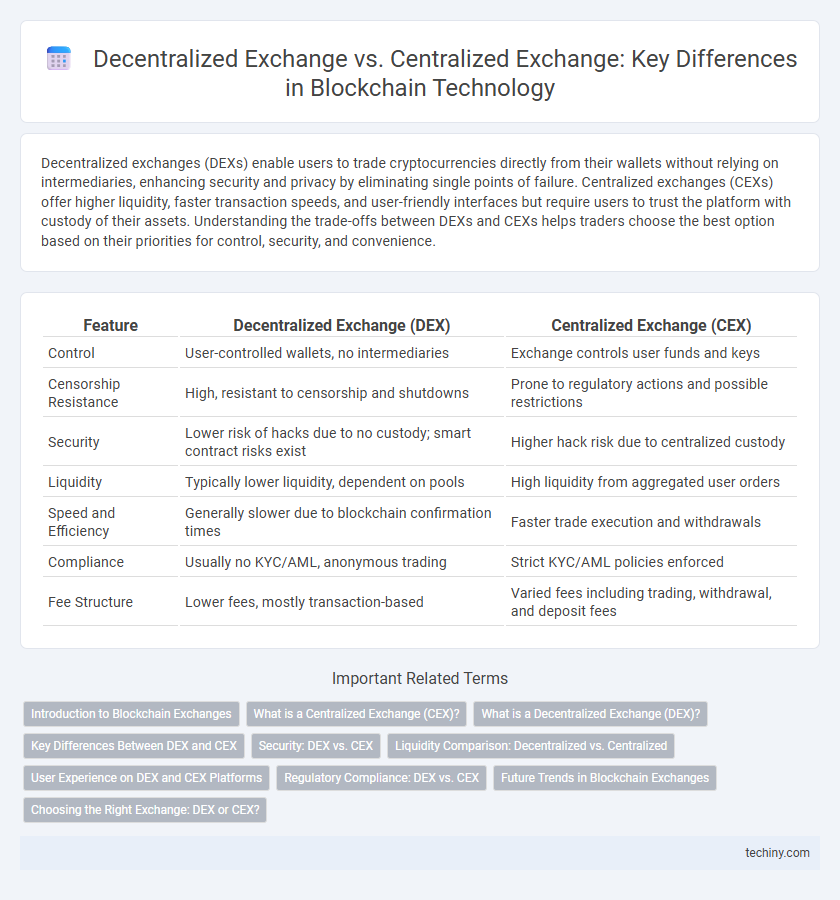Decentralized exchanges (DEXs) enable users to trade cryptocurrencies directly from their wallets without relying on intermediaries, enhancing security and privacy by eliminating single points of failure. Centralized exchanges (CEXs) offer higher liquidity, faster transaction speeds, and user-friendly interfaces but require users to trust the platform with custody of their assets. Understanding the trade-offs between DEXs and CEXs helps traders choose the best option based on their priorities for control, security, and convenience.
Table of Comparison
| Feature | Decentralized Exchange (DEX) | Centralized Exchange (CEX) |
|---|---|---|
| Control | User-controlled wallets, no intermediaries | Exchange controls user funds and keys |
| Censorship Resistance | High, resistant to censorship and shutdowns | Prone to regulatory actions and possible restrictions |
| Security | Lower risk of hacks due to no custody; smart contract risks exist | Higher hack risk due to centralized custody |
| Liquidity | Typically lower liquidity, dependent on pools | High liquidity from aggregated user orders |
| Speed and Efficiency | Generally slower due to blockchain confirmation times | Faster trade execution and withdrawals |
| Compliance | Usually no KYC/AML, anonymous trading | Strict KYC/AML policies enforced |
| Fee Structure | Lower fees, mostly transaction-based | Varied fees including trading, withdrawal, and deposit fees |
Introduction to Blockchain Exchanges
Blockchain exchanges enable the trading of cryptocurrencies through two primary models: decentralized exchanges (DEX) and centralized exchanges (CEX). DEX platforms operate on blockchain technology, allowing peer-to-peer trading without intermediaries, enhancing security and user control over assets. CEX platforms function as intermediaries that facilitate trades with higher liquidity and faster transactions but require trusting a centralized authority with custody of funds.
What is a Centralized Exchange (CEX)?
A Centralized Exchange (CEX) is a cryptocurrency trading platform operated by a centralized entity that controls user funds and order matching. CEXs offer higher liquidity, faster transaction speeds, and user-friendly interfaces but require users to trust the exchange with their private keys and personal information. Popular examples of CEXs include Binance, Coinbase, and Kraken, which facilitate fiat-to-crypto and crypto-to-crypto trading with regulatory compliance.
What is a Decentralized Exchange (DEX)?
A Decentralized Exchange (DEX) operates without a central authority, allowing users to trade cryptocurrencies peer-to-peer on a blockchain network. It leverages smart contracts to facilitate secure, transparent, and trustless transactions while maintaining user custody of private keys. DEXs offer increased privacy, reduced counterparty risk, and greater resistance to censorship compared to Centralized Exchanges (CEX).
Key Differences Between DEX and CEX
Decentralized Exchanges (DEX) operate without intermediaries, enabling peer-to-peer cryptocurrency trading directly on blockchain networks, enhancing privacy and security. Centralized Exchanges (CEX) function through a central authority that manages user funds and order matching, offering higher liquidity and faster transaction speeds but requiring trust in the platform's security. Key differences include custody control, with users retaining private keys on DEXs versus third-party custody on CEXs, and varying regulatory compliance and user experience levels.
Security: DEX vs. CEX
Decentralized exchanges (DEXs) enhance security by eliminating a central authority, reducing the risk of hacking and insider threats commonly seen in centralized exchanges (CEXs). Users retain control over their private keys on DEXs, minimizing exposure to exchange-related breaches and theft. In contrast, CEXs are more vulnerable to security incidents due to centralized custody, making them prime targets for large-scale cyberattacks.
Liquidity Comparison: Decentralized vs. Centralized
Centralized exchanges (CEXs) typically offer higher liquidity due to aggregated order books and large user bases, enabling faster trades and better price stability. Decentralized exchanges (DEXs) rely on liquidity pools and automated market makers (AMMs), which can result in lower liquidity and higher slippage, especially for less popular token pairs. However, advancements in Layer 2 solutions and cross-chain liquidity protocols are progressively enhancing DEX liquidity, narrowing the gap with centralized platforms.
User Experience on DEX and CEX Platforms
Decentralized exchanges (DEXs) provide users with direct control over their private keys and funds, enhancing security and reducing counterparty risk compared to centralized exchanges (CEXs). However, DEX platforms often face challenges in user experience due to slower transaction speeds, limited liquidity, and more complex interfaces, which can be less intuitive for newcomers. In contrast, CEXs offer faster trade execution, higher liquidity, and user-friendly interfaces, but require users to trust the platform with custody of their assets, potentially increasing vulnerability to hacks and regulatory issues.
Regulatory Compliance: DEX vs. CEX
Centralized exchanges (CEX) operate under strict regulatory frameworks, requiring user identification through KYC and AML protocols to ensure compliance with global financial laws. Decentralized exchanges (DEX) provide peer-to-peer trading without intermediaries, often bypassing traditional regulatory oversight due to their non-custodial nature and lack of centralized control. Regulatory compliance challenges for DEX platforms include increased scrutiny and potential legal risks as authorities seek to impose similar standards on decentralized finance (DeFi) activities.
Future Trends in Blockchain Exchanges
Decentralized exchanges (DEXs) are projected to dominate future blockchain trading due to their enhanced security, user control over assets, and resistance to censorship compared to centralized exchanges (CEXs). Innovations such as cross-chain compatibility and improved liquidity protocols are driving the evolution of DEXs, enabling seamless asset swaps across multiple blockchains. Meanwhile, centralized exchanges are integrating decentralized finance (DeFi) features and adopting hybrid models to maintain competitiveness in the rapidly growing blockchain ecosystem.
Choosing the Right Exchange: DEX or CEX?
Choosing the right exchange depends on factors like security, control, and liquidity; decentralized exchanges (DEX) offer enhanced privacy and user control by eliminating intermediaries, while centralized exchanges (CEX) provide higher liquidity and faster transaction speeds. Users prioritizing asset custody and reduced counterparty risk may prefer DEX platforms built on blockchain protocols such as Ethereum or Binance Smart Chain. Conversely, traders seeking ease of use, customer support, and extensive trading pairs typically favor CEX platforms like Binance or Coinbase.
Decentralized Exchange vs Centralized Exchange Infographic

 techiny.com
techiny.com